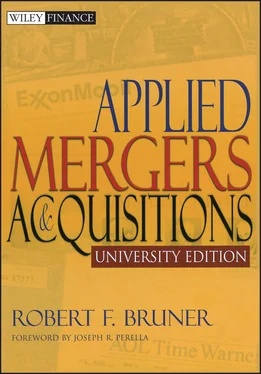JV is in a favorable foreign environment, in terms of laws and regulations. Returns from JVs vary by country and region, consistent with the discussion in Chapter 5that variations in deregulation and rule of law will affect investment returns.
EXHIBIT 6.13 Summary of Studies of Market Returns to Parent Shareholders at Announcements about Joint Ventures, Alliances, and Minority Equity Investments
| Study |
Cumulative Abnormal Returns at the Event |
Cumulative Abnormal Returns after the Event |
Sample Size |
Sample Period |
Notes |
| Gleason, Mathur, Wiggins (2003) |
+0.51% *full sample +0.45% *domestic +0.60% *international +0.61% *horizontal +0.47% *diversifying |
+7.94% †full sample +9.40% †domestic +4.05% international +14. 79% †horizontal +5.10% diversifying (months +1,+18) |
638 311 197 134 376 |
1985–1998 |
Sample of deals involving financial services institutions. |
| Ferris et al. (2002) |
+0.52% *whole sample +0.71% *focus-increasing JVs 0.11% focus-decreasing JVs (all estimates are around days –1,0) |
+5.31% whole sample +9.43% †focus-increasing –1.42% focus-decreasing (estimates around months 1,36) |
325 200 125 |
1987–1996 |
Sample of international JVs by Singaporean firms. |
| Johnson, Houston (2000) |
+ 1.67% horizontal JVs +5.0% suppliers in vertical JVs 0.0% buyers in vertical JVs |
N/A |
85 horizontal JVs 106 Vertical JVs |
1991–1995 |
Compared returns to JV investors with returns to firms using simple contracts. |
| Schut, van Frederikslust (undated) |
+0.40% (days–1,0) * |
|
233 |
1987–1998 |
Sample of Dutch JVs. |
| Chen, Ho, Lee, Yeo (2000) |
+0.96% (days–1,0) * |
|
174 |
1979–1993 |
International JV announcements by Singaporean firms. |
| Allen, Phillips (2000) |
+9.1% *alliance, JV target +0.1% alliance, JV purchaser +5.5% *no alliance, JV target –1.1% no alliance, JV purchaser +8.3% *alliance, JV with board representation, target –0.4% alliance, JV with board representation, purchaser (all estimates are around days –10,+10) |
|
150 150 252 252 92 92 |
1980–1991 |
|
| Chan, Kensinger, Keown, Martin (1997) |
+0.64% *whole sample, day 0 +3.45% *horizontal alliance involving tech transfer +1.00% horiz, nontech +1.45% *nonhoriz, nontech +0.27% nonhoriz, tech transfer |
|
345 |
1983–1992 |
Sample of strategic alliances. |
| Koh, Venkatraman (1991) |
+0.87% *full sample +0.80% *tech exchanges subsample 0.40% licensing agreements 0.01% marketing agreements –0.13% supply agreements |
|
175 |
1972–1986 |
|
| Chen, Hu, Shieh (1991) |
+0.71% *full sample (days –1,0) |
|
88 |
1979–1990 |
International JVs in China by U.S. firms. |
| Crutchley et al. (1991) |
+1.05% †U.S. partner returns +1.08% †Japanese partner returns |
|
82 |
1979–1987 |
Japanese-U.S. JVs. |
| Lee, Wyatt (1990) |
–0.466% †full sample |
|
109 |
1974–1986 |
|
| McConnell, Nantel (1985) |
+0.73% full sample (days –1,0) + 1.10% small firm subsample +0.63% large firm subsample |
|
210 |
1972–1979 |
|
Unless otherwise noted, event date is announcement date of transaction.
*Significant at the 0.99 level or better.
†Significant at the 0.95 level.
RESTRUCTURING, REDEPLOYMENT, AND SALE
Restructuring is a lengthy process. Donaldson (1990) documented a restructuring program (consisting of many discrete transactions) at General Mills that spanned two decades. Kaiser and Stouraitis (2001) described the restructuring of Thorn-EMI that encompassed numerous transactions and lasted 13 years. Boone and Mulherin (2001, 2002) found that the median length of targeted restructuring events is 345 days and that the investor reactions to the initial and subsequent announcements are significantly positive. Their analysis of the auction processes in these restructurings finds the highest returns from asset sales to be associated with the entry of multiple publicly owned bidders.
The motives for exit mirror those for entry: the adverse effects of industry turbulence; the need to exit from unattractive businesses. As Chapter 3reveals, not all acquisitions are successes. And even for good businesses, the forces of competition, turbulence, and the life cycle can bring an end to a period of good performance. Jensen (1999) noted that “Exit problems appear to be particularly severe in companies that for long periods enjoyed rapid growth, commanding market positions, and high cash flow and profits.” (Page 583) He cited the reluctance of U.S. automobile tire manufacturers to close factories that produced the bias-ply tire when it became apparent that the radial tire product would displace it.
SHARPEN STRATEGIC FOCUSA portfolio of unrelated business activities requires senior management to master a wide variety of industrial concepts and to monitor disparate businesses. A portfolio organized around a focused strategy can exploit executive expertise in neighboring businesses. Weston (1989) argued that dismantling inefficient conglomerates was an important motive for divestitures and restructurings.
CORRECT “MISTAKES” AND HARVEST “LEARNING”Porter (1987) studied the acquisitions of diversified firms and found high rates of divestiture in the years following acquisition—on average, they divested 53 percent of their acquisitions within a few years. This implied to Porter a large failure rate in corporate acquisition. Weston (1989) replied that this rate of divestiture could be explained by a variety of effects such as antitrust enforcement and the harvesting of mature investments. He wrote, “Divestitures seem as likely to reflect past successes as mistaken attempts at diversification. Some are pre-planned for good business reasons. Some represent harvesting of sound investments. And some reflect organizational learning that contributes to improvements in future strategies…. Regardless of which version one accepts as the dominant explanation for divestitures—‘mistakes’ or ‘learning’—the persistently high numbers and values of such transactions constitute reliable evidence that the market system is working, ensuring the mobility of resources essential to the effective operation of an enterprise economy.” ( Pages 75– 76)
CORRECT THE MARKET VALUATION OF ASSETSExecutives frequently complain that the stock market doesn’t understand their firms and that it is worth more than the current price suggests. Restructuring can monetize undervalued assets. The firm may contain business units to which investors attribute little or no value. Restructuring can help to establish a monetary value for those assets. If certain business units would be worth more standing alone, a restructuring can exploit a pure-play premium (avoid a diversification discount). Investors may have an appetite for single-segment firms—the common argument is that these kinds of firms are easier to understand, and permit the investor more easily to construct efficient portfolios of securities. Finally, there may be a known buyer to whom the assets or business unit are worth significantly more than to your firm. A restructuring can redeploy assets to higher-valued uses. Your firm may be operating an asset effectively, but there may be alternative uses for the asset that create even more value.
Читать дальше












